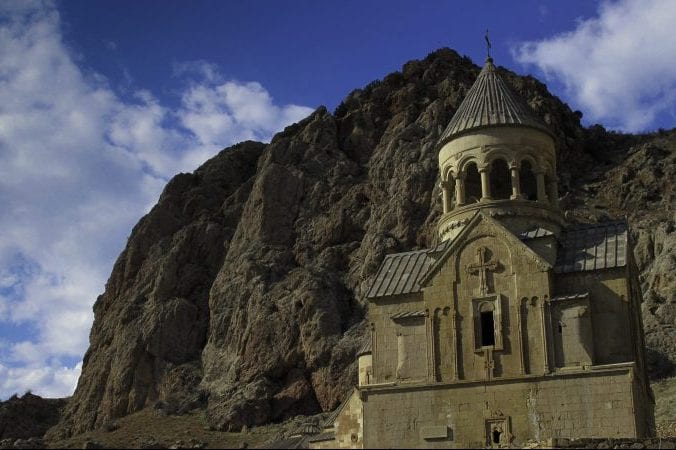| A decade ago, Armenian wine was barely on anyone’s radar - it was only in 2011 that Zorah winery revealed its first wines and started to show that there is something special about this country. Coincidentally, it was also in 2011 that the discovery of the world’s oldest winery was announced in a karst cave named Areni-1 in the Armenian highlands of Vayots Dzor. It’s an eerie place to visit – full of clay wine jars (called karasi in Armenian) with a rudimentary wine press and traces of grape pigments and alcohol. Significantly, the karasi are surrounded by by grave caskets showing that wine was already at the heart of human ritual over 6,100 years ago. There’s evidence that winemaking has continued on throughout Armenia’s history, though wine definitely suffered during the Soviet era as Stalin designated the Armenian Soviet Socialist Republic as a brandy producer. The country provided around 30% of the USSR’s premium brandy and as a result many vineyards were replanted with grapes for distillation. Historically Armenia grew up to 400 varieties, but today only 31 are grown commercially for wine and brandy. Many Armenian diaspora are proud of their roots and are returning to invest in their homeland, wanting to do something close to the soil, so wine is an obvious choice. But passion and money alone are not enough, there has to be more to it. Armenia is a continental country with 300 sunny days, long sunshine hours and is mostly underlaid with volcanic bedrock with outcrops of limestone. Altitude is an important factor too – most of the important vineyard regions are over 1,000 metres above sea level, with some vines growing up to 1,800 metres (Keush sparkling wine comes from this altitude) and this means cool nights which protect that all-important acidity and freshness of flavour. Winters can be so cold that vines have to be buried in most regions. Much of the country is still phylloxera-free, so where vines escaped replanting for brandy, there are some seriously old plots, possibly centuries-old, especially the highlands. Armenia also has several unique local grapes that are proving capable of making exciting wines: reds like Areni, Sireni, Haghtanak and Kakhet and whites such as Voskehat, Khatouni and the rare Chilar. A couple of more recent local crosses – Kangun and Karmrahyut – can also produce quality wines. It’s a positive sign that world-renowned consultants like Alberto Antonini (helping Zorah), Michel Rolland (at Tierras de Armenia with its Karas brand) and Stéphane Derenoncourt (at Voskeni) are working here, in this almost unheard-of country, suggesting real potential. Tourism is still small but growing and visitors can be sure of a warm welcome. The capital Yerevan has fascinating history and a lively café culture too. The landscape is dotted with dramatic churches and monasteries (Armenia was the first official Christian country in the world), overlooked by the snow-capped Mount Ararat. A trip across the highlands on the historic silk road is amazing, passing fields of wildflowers, historic caravanserai and cultural sites. There’s even a wine route in Vayots Dzor region with places to stay, eat tasty local food with its eastern and western influences, and taste this small country’s amazing wines. | |
| AUTHOR Caroline Gilby MW is a freelance writer specializing in the wines of Central and Eastern Europe. She is author of The Wines of Bulgaria, Romania and Moldova and chairs the panel of Eastern Europe wine judges at the Decanter World Wine Awards. |
FACT FILE ArmeniaArea and production: Vineyard area (2018): 15,840 ha. Number of wineries/distilleries: 40 to 50. Wine production (2018): 9.7 million litres Grape varieties: 400 native varieties, 31 grown for wine and brandy. Key native varieties: Areni (Noir) aka Sev Areni, Voskehat, Haghtanak aka Akhtanak, Kangun, Kakhet, Karmrahyut, Khatouni aka Khatoun Kharji, Sireni aka Khndoghni Wine Regions: Vayots Dzor, Armavir, Aragatsotn, Ararat Valley, Tavush, Artsakh (Nagorno-Karabakh) Selected Recommended Producers: Zorah, Van Ardi, Old Bridge, Trinity Canyon, Tierras de Armenia, Keush, Highland Cellars, Maran, Voskevaz, Voskeni, Gevorkian, ArmAs, Armenian Wine Company |
Modern Armenia Meets the Roots of Wine




